
By Michael McClenathan
Although the central city has a residential population just under 100,000 people, over 771,000 people access the City of Melbourne every weekday, and that number is expected to grow to over one million by 2020 (City of Melbourne, 2009, p. 32). Most visitors come from Melbourne’s surrounding metropolitan area, from which 46% access the city by car, and 47% use public transportation (Hughes & Gibney, 2010). The Melbourne public transport system and Melbourne’s roads are both generally regarded as very stressed (City of Melbourne, 2009, pp. 32’33). What follows is an assessment of climate risks (Mehrotra et al., 2009) facing the transport sector in Melbourne, as well as interventions that can address these risks.
According to Church, et al. (2008), in a 0.5 meter sea-level rise scenario (plausible by 2070), current 1:100 year floods could occur in Melbourne multiple times a year (as cited in City of Melbourne, 2009, p. 22). In addition to the displacement of residents, such flooding has the potential to prevent Melbourne’s workforce from accessing the city or to strand large populations in the center city for extended periods of time (City of Melbourne, 2009, p. 60). Thus, transportation shutdowns due to extreme flooding will have economic and humanitarian costs beyond the cost of general cleanup incurred after a flood event.
Extreme heat also poses a direct threat to Melbourne transport. Sustained high temperatures can cause asphalt to rut and steel rail tracks to buckle, causing delays and possibly derailments. Furthermore, health issues related to extreme heat directly impact transport operations. In 2008, in the month of March alone, 894 services held up by 25 instances of passenger illness (City of Melbourne, 2009, p. 32). As temperatures increase, so will heat-related illnesses and related service delays.
Roads and rails must be upgraded to take climate change projections into account. This should be accomplished during normal repair cycles to minimize cost and interruption.
Efforts should be made to improve public awareness of emergency procedures, such as how best to access medical services and safe shelters,, which exist throughout the city near major transit hubs to accommodate stranded populations in flood emergencies (City of Melbourne, 2009, p. 64).
Melbourne already has a heatwave alert system in place (City of Melbourne, 2009, p. 108). Because many floods will be due to relatively predictable storms, Melbourne should also have an early flood alert system. If a storm is expected to cause flooding, The City of Melbourne might be able to lessen its transport impact simply by asking (or ordering) people not to come to the city that day, or by preemptively shutting down flood-prone lines.
In 2006, the state of Victoria committed AUD 10.5 billion (2006 USD ~8 billion) to improving transport infrastructure over a ten year span, more than half of which was for Melbourne (State of Victoria, 2006). Incorporation of worst-case climate change projections for heat and increased flood frequency into the engineering specifications of these plans must be required before these improvements are approved.
Many of Melbourne’s most productive firms are financial and insurance services (.id Consulting, 2011) that may not need workers to be physically present every day. Melbourne should explore policies such as tax incentives and a public information campaign to encourage firms to install telecommuting systems. Regular telecommuting might relieve some stress on overloaded transport systems, and the ability to telecommute during emergencies will allow firms to continue operations even if workers are unable to reach the city center during lengthy transport outages.
This article is a product of Professor Shagun Mehrotra’s Climate Change and Cities class. Views expressed are entirely those of the individual author.
.id Consulting. (2011). Value added by industry – City of Melbourne. Retrieved November 3, 2011, from economy.id: http://economy.id.com.au/Default.aspx?id=128&pg=12210
Church, J., White, N., Hunter, J., McInnes, K., Cowell, P., & O’Farrell. (2008). Sea-level rise and the vulnerability of coastal environments. In P. W. Newton (Ed.), Transitions, Pathways Towards Sustainable Urban Development in Australia. Collingwood, Australia: CSIRO Publishing.
City of Melbourne. (2009). City of Melbourne Climate Change Adaptation Strategy. Retrieved October 5, 2011, from http://www.melbourne.vic.gov.au/AboutCouncil/PlansandPublications/strategies/Documents/climate_change_adaptation_strategy.PDF
Commonwealth of Australia. (2011). Climate change risks to coastal buildings and infrastructure: a supplement to the first pass natIonal assessment. Department of Climate Change and Energy Efficiency.
Hughes, P., & Gibney, N. (2010). Central City users survey 2010. Retrieved November 3, 2011, from http://www.melbourne.vic.gov.au/AboutMelbourne/Statistics/Pages/CityUsers.aspx
Mehrotra, S., C.E. Natenzon, A. Omojola, R. Folorunsho, J. Gilbride & C. Rosenzweig. (2009). Framework for city climate risk assessment. Washington, DC: World Bank.
Mehrotra, S., Lefevre, B., Zimmerman, R., Gercek, H., Jacob, K., & Srinivasan, S. (2011). Climate change and urban transportation systems. In C. Rosenzweig, W. D. Solecki, S. A. Hammer, & S. Mehrotra (Eds.), Climate Change and Cities: First Assessment Report of the Urban Climate Change Research Network (pp. 145-177). Cambridge, UK: Cambridge University Press.
Melbourne City Council. (2011). Annual plan and budget 2011-2012. Retrieved October 5, 2011, from City of Melbourne: Council 2011 meeting documentation: http://www.melbourne.vic.gov.au/AboutCouncil/Meetings/Pages/09May2011.aspx
State of Victoria. (2006). Meeting our transport challenges. Department of Infrastructure, Melbourne.